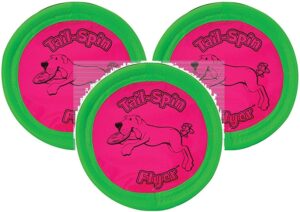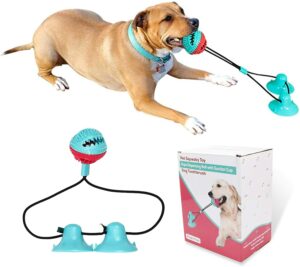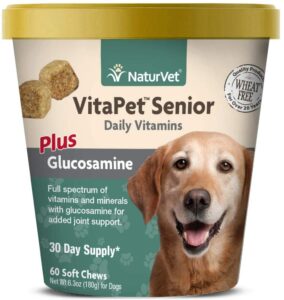As dogs get older, they don’t need as much physical activity. Unlike puppies or younger dogs, they don’t have a ton of energy they need to burn off every day.
Senior dogs are usually content to sleep a lot and relax, and at this stage of their lives, that’s exactly what they should be allowed to do. However, exercise is important for dogs, at any age. In this post, we’ll discuss how to exercise senior dogs and what safety precautions to take.
This post contains affiliate links. If you make a purchase, I’ll earn a commission (at no extra cost to you). As an Amazon Associate, I earn from qualifying purchases. I donate 10% of my earnings to animal charities.
Watch My Video: Exercising Eldery Dogs
Exercising Senior Dogs
Exercise stimulates blood flow, which helps deliver oxygen to all tissues and helps remove toxins. Exercise helps bowel function enormously, and this is especially important for older dogs.
Exercise helps keep muscles strong and joints flexible, and helps burn calories so the dog doesn’t suffer with a weight problem. So exercising senior dogs is important. Here are some tips to keep in mind as your dog enters his senior years.
Provide a Level of Physical Activity That’s Appropriate for the Dog
It’s always important, when choosing a dog, to get a breed that matches your energy level and lifestyle. You might, for example, choose to get a dog who will love those morning runs with you.
But as that same breed ages, he will slow down. So even if a dog was extremely physically active in his younger years, don’t expect that same level of intensity as he ages.
Let the dog dictate what his exercise level is going to be. Let him decide whether he runs or walks – whether he goes fast or slow – and whether he goes for two hours or ten minutes.
You really have to pay attention to what the dog is physically capable of doing. A dog who used to run five miles with you each morning may, in his old age, have difficulty walking over to the neighbor’s house and back.
And that’s OK. Let him enjoy the level of physical activity that he’s comfortable with.
Walking Senior Dogs
If you choose to exercise outside with your dog, make sure the weather is suitable.
Dogs can get heatstroke or frostbite, and you have to be especially careful with senior dogs, as they are more vulnerable to this.
If you’re walking your dog in the winter time, please read this article, Dogs and Cold Weather – When is it too Cold?
Walking is a great exercise for senior dogs. Start slow with just a short walk each day, then slowly increase the distance (or not, if you think your dog is doing the most he can).
Playtime for Senior Dogs
Interactive playtime is another great way to provide exercise for your dog.
Playing fetch if he’s still able, tug-of-war (gently – old teeth!), throwing a frisbee.
Here’s a great item I found recently – it’s called a Tail Spin Flyer. This item is fun and safe for your dog, and it’s soft and gentle on your senior dog’s teeth and gums. And it comes in several different sizes.
Interactive Toys for Senior Dogs
Interactive toys are a wonderful way to not only provide exercise for your senior dog, but to help keep his mental abilities sharp.
CLICK HERE for a list of really fantastic toys for older dogs.
Provide Good Nutrition for Senior Dogs
Good nutrition is important at any age, but particularly so for an older dog. Make sure you provide your senior dog with a high-quality food.
Weight is a big issue as they get older as well.
Gaining too much weight will cause all kinds of preventable health problems, so it’s important to pay attention to what they’re eating.
It’s also important to provide your dog with a high-quality vitamin and mineral supplement.
Best Dog Food for Senior Dogs
According to The Farmer’s Dog, more than 80% of dogs get some form of dental disease in their lifetime. That’s roughly the same percentage of dogs who eat dry food. Almost 60% of dogs are overweight or obese.
Half of dogs over the age of 10 will develop cancer, but most dogs don’t make it to that age to begin with.
So how do you solve the problem? It starts with what we feed them. I recommend fresh dog food, particularly The Farmer’s Dog. Click here to read my full review, or click below for 50% off your first box!
Swimming is a Great Way to Exercise a Senior Dog
Swimming is a great activity for dogs of all ages, but it’s particularly beneficial for older dogs because it’s low-impact and easy on weakening joints and muscles.
Swimming also builds strength, provides a good cardio workout, and it’s naturally relaxing and comforting for most dogs.
But only expect your dog to swim if he wants to and enjoys it. Never force a dog into the water against his will.
Never leave your dog unsupervised near water, and I would strongly suggest purchasing a life jacket. Senior dogs can easily tire – they need the help to stay afloat. You can find a nice variety of life jackets with good prices at Amazon.com.
Make Sure Your Dog Gets Outside
Even though he may not be able to go for walks as often, or play Frisbee in the back yard with the kids, or chase a stick for hours at the lake, your dog will still enjoy being outside.
He needs sunshine and fresh air like everyone else!
So if nothing else, let your dog be outside with you and your family. He may be content to relax in the grass while you do gardening, for example, or he may enjoy snoozing in a dog bed on the patio while you BBQ.
Grass. Dirt. It’s all good.
Make Modifications for Your Senior Dog
Some things become habit, and a lot of our lives are spent doing the same things we always do – because that’s the way we’ve always done it.
But as your dog gets older, he may not do things the way he always has, and you have to be willing to adjust to that.
Maybe your dog used to get you up at 5 a.m. every morning. Now he’s still snoozing at 7:30. It’s ok! Or maybe he used to wolf down his breakfast in 90 seconds flat, but now he munches slowly and it takes him all morning to finish it. Again, it’s ok.
Your dog might need more help with things as well. He might need you to carry him outside or up and down stairs or at least install a dog ramp to make his getting around easier.
He may need you to help him eat. He may need you to switch to canned food because he doesn’t have as many teeth as he used to. He may lose his sight or hearing and need you to be his eyes and ears.
Please, try as hard as you can to pay attention to any difficulties your older dog might be having and do everything you can to make his life easier. For all you two have been through together, he deserves it! You can find a variety of dog ramps HERE.
Don’t Expect Senior Dogs to Behave Like Young Dogs
And certainly don’t punish them if they don’t. Bladder control issues, for example, become a big problem (for people too!) in old age.
A senior dog having trouble controlling his bladder is not something to punish, nor is anything else he may be having trouble with.
An older dog will be more work for you – you have to accept that. He’ll need to go outside far more often, he’ll need help doing things, he’ll need you to watch out for him more.
Accept him for what he is – an old dog who’s been around a long, long time. Give him the respect he’s earned!
Watching Your Older Dog Slow Down Can be Difficult
It can be heartbreaking to watch the activity level in our dogs decrease over time. But just like with humans, slowing down is a natural part of life and is a part of aging.
It may help to think about it this way: When you’re 90, do you really want someone tossing you into a swimming pool, or dragging you for walks at the park every morning, or tossing a ball and expecting you to run after it?
No! You want to sit in your recliner and read – or sit on the porch in the sun and relax.
Your dog is the same way. You don’t necessarily have to provide stimulation at this senior stage of your dog’s life. What you want to provide is relaxation. Enjoy this time and celebrate your dog’s life!
Caring for a Senior Dog
For more help with caring for an elderly dog, read my article, 10 Tips When Caring for a Senior Dog or watch my video.
More Information About Senior Pet Care
- How to Help an Aging Cat
- Exercising Senior Dogs
- Is It Too Late to Train My Dog? You Can Teach an Old Dog New Tricks
- What Are the Benefits of Adopting Senior Pets?
- 10 Tips When Caring for a Senior Dog
I Donate to Animal Charities
Thank you for visiting my website. I’m glad you’re educating yourself on how to take care of your dog as they get older. They’re lucky to have you!
I donate 10% of my earnings to animal charities. You can see a list of the charities I donate to here.
If you like this website, please share it with your friends and family who have a pet. Thank you! Debra
















This is super information on senior dogs. Exercising senior dogs can be a bit confusing as you don’t want to “over do it.”
As you mention in your post, they’re not puppy’s anymore, but they still need activity.
Two things that really stood out to me in this post were the interactive toys and the swimming. What fantastic ideas! I’d never would have thought of either of these activities. I’ll certainly be implementing these types of exercises for my aging dog.
Is there a certain amount of hours per day we should be keeping our senior dogs active or does this depend on the individual dog?
Thanks again for this awesome info on exercising senior dogs. Fantastic!
Thanks so much, Stephen. I think the amount of exercise should be up to the dog – they’re pretty good at letting us know when they’ve had enough. I had a mini doxy once would would just sit down on a walk. Like all of a sudden, “ok, I’m done!” LOL
Ciao ,i think dogs know what do they need and we can leave them do what makes them happy but over feeding them , so the more they move the better ,im writing this and i just finished bouncing my football with my dog it’s a sunny day today in Milano ,best of luck on your site & its a great job you’re doing here
Thank you so much. I’m sure your dog loves playing ball with you!